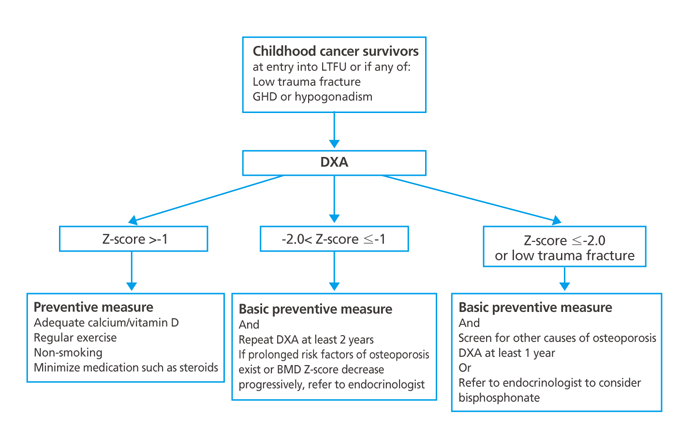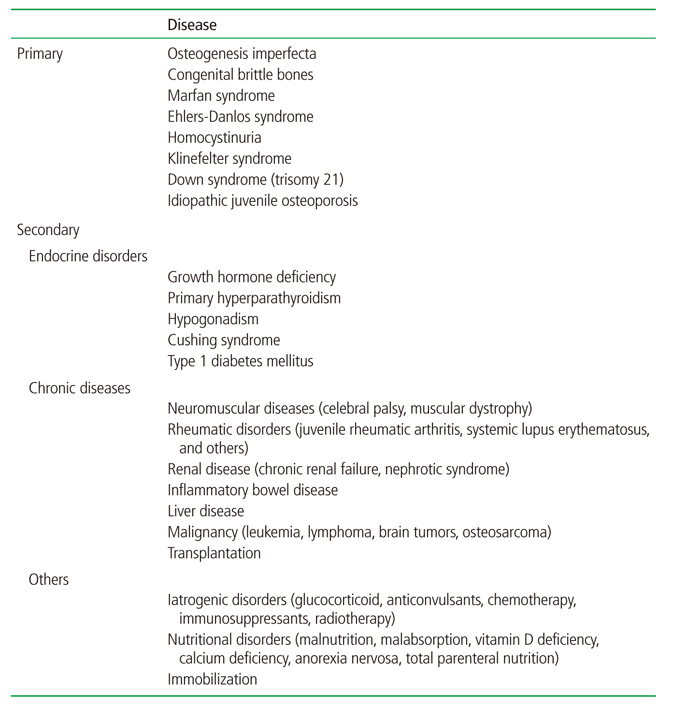 |
 |
- Search
| J Korean Med Assoc > Volume 61(10); 2018 > Article |
Abstract
Osteoporosis was once thought to be a disease of the elderly. Now, there is universal agreement that osteoporosis has a pediatric origin. If individuals fail to achieve optimal peak bone mass and strength in childhood and adolescence, the development of osteoporosis later in life becomes more likely. Furthermore, increased knowledge and improved care for children with genetic disease and chronic illnesses has led to many children living long enough to develop osteoporosis and fractures even in childhood or adolescence. Thus, early interventions including nutrition, exercise, and pharmacological treatment are paramount. The objective of this review is to help clinicians diagnose and manage children at a high risk of osteoporosis. This article also reviews the latest advances in the treatment of pediatric osteoporosis including Korean experiences.
References
1. Riggs BL, Melton LJ. Osteoporosis: etiology, diagnosis, and management. New York: Raven Press; 1988.
3. Heaney RP, Abrams S, Dawson-Hughes B, Looker A, Marcus R, Matkovic V, Weaver C. Peak bone mass. Osteoporos Int 2000;11:985-1009.



4. Lim JS. Pediatric dual-energy X-ray absorptiometry: interpretation and clinical and research application. Korean J Pediatr 2010;53:286-293.

5. Saraff V, Hogler W. Endocrinology and adolescence: Osteoporosis in children: diagnosis and management. Eur J Endocrinol 2015;173:R185-R197.


6. Osteoporosis prevention, diagnosis, and therapy. NIH Consens Statement 2000;17:1-45.
7. Bishop N, Arundel P, Clark E, Dimitri P, Farr J, Jones G, Makitie O, Munns CF, Shaw N. International Society of Clinical Densitometry. Fracture prediction and the definition of osteoporosis in children and adolescents: the ISCD 2013 Pediatric Official Positions. J Clin Densitom 2014;17:275-280.


8. Lim JS, Hwang JS, Lee JA, Kim DH, Park KD, Cheon GJ, Shin CH, Yang SW. Bone mineral density according to age, bone age, and pubertal stages in Korean children and adolescents. J Clin Densitom 2010;13:68-76.


9. Yi KH, Hwang JS, Kim EY, Lee JA, Kim DH, Lim JS. Reference values for bone mineral density according to age with body size adjustment in Korean children and adolescents. J Bone Miner Metab 2014;32:281-289.



10. Goulding A, Jones IE, Taylor RW, Manning PJ, Williams SM. More broken bones: a 4-year double cohort study of young girls with and without distal forearm fractures. J Bone Miner Res 2000;15:2011-2018.


11. Venturi G, Tedeschi E, Mottes M, Valli M, Camilot M, Viglio S, Antoniazzi F, Tato L. Osteogenesis imperfecta: clinical, biochemical and molecular findings. Clin Genet 2006;70:131-139.


12. Lim JS. Treatments of osteoporosis in pediatric fields. J Korean Soc Pediatr Endocrinol 2006;11:138-147.
14. Lim JS, Lee DH. Changes in bone mineral density and body composition of children with well-controlled homocystinuria caused by CBS deficiency. Osteoporos Int 2013;24:2535-2538.



15. Ward LM, Glorieux FH. The spectrum of pediatric osteoporosis. In: Glorieux FH, Pettifor JM, Juppner H, editor. Pediatric bone: biology and disease. Boston: Academic Press; 2003. p. 401-441.
16. Jung KJ, Kwon SS, Chung CY, Lee KM, Sung KH, Cho BC, Chung MK, Moon SJ, Kim J, Park MS. Association of gross motor function classification system level and school attendance with bone mineral density in patients with cerebral palsy. J Clin Densitom 2016;10. 11. [Epub]. https://doi.org/10.1016/j.jocd.2016.09.002


17. Laakso S, Valta H, Verkasalo M, Toiviainen-Salo S, Makitie O. Compromised peak bone mass in patients with inflammatory bowel disease: a prospective study. J Pediatr 2014;164:1436-1443.


18. Kyriakou A, Shepherd S, Mason A, Ahmed SF. Prevalence of vertebral fractures in children with suspected osteoporosis. J Pediatr 2016;179:219-225.


19. Soyka LA, Grinspoon S, Levitsky LL, Herzog DB, Klibanski A. The effects of anorexia nervosa on bone metabolism in female adolescents. J Clin Endocrinol Metab 1999;84:4489-4496.


20. Kang MJ, Lim JS. Bone mineral density deficits in childhood cancer survivors: Pathophysiology, prevalence, screening, and management. Korean J Pediatr 2013;56:60-67.



21. Choi YJ, Park SY, Cho WK, Lee JW, Cho KS, Park SH, Hahn SH, Jung MH, Chung NG, Cho B, Suh BK, Kim HK. Factors related to decreased bone mineral density in childhood cancer survivors. J Korean Med Sci 2013;28:1632-1638.




22. Kang MJ, Kim SM, Lee YA, Shin CH, Yang SW, Lim JS. Risk factors for osteoporosis in long-term survivors of intracranial germ cell tumors. Osteoporos Int 2012;23:1921-1929.



23. Atkinson SA, Halton JM, Bradley C, Wu B, Barr RD. Bone and mineral abnormalities in childhood acute lymphoblastic leukemia: influence of disease, drugs and nutrition. Int J Cancer Suppl 1998;11:35-39.


24. Fratzl-Zelman N, Valta H, Pereira RC, Misof BM, Roschger P, Jalanko H, Wesseling-Perry K, Klaushofer K, Makitie O. Abnormally high and heterogeneous bone matrix mineralization after childhood solid organ transplantation: a complex pathology of low bone turnover and local defects in mineralization. J Bone Miner Res 2017;32:1116-1125.



25. Children's Oncology Group. Long-term follow-up guidelines for survivors of childhood, adolescent, and young adult cancers, ver. 4.0 [Internet] Philadelphia: Children's Oncology Group. c2018;cited 2018 Jun 15. Available from: http://survivorshipguidelines.org/
26. Lee WT, Leung SS, Wang SH, Xu YC, Zeng WP, Lau J, Oppenheimer SJ, Cheng JC. Double-blind, controlled calcium supplementation and bone mineral accretion in children accustomed to a low-calcium diet. Am J Clin Nutr 1994;60:744-750.


27. Greene DA, Naughton GA. Calcium and vitamin-D supplementation on bone structural properties in peripubertal female identical twins: a randomised controlled trial. Osteoporos Int 2011;22:489-498.



28. Ross AC, Taylor CL, Yaktine AL, Del Valle HB. Dietary reference intakes for calcium and vitamin D. Washington, DC: The National Academies Press; 2011.
29. Kim SH, Oh MK, Namgung R, Park MJ. Prevalence of 25-hydroxyvitamin D deficiency in Korean adolescents: association with age, season and parental vitamin D status. Public Health Nutr 2014;17:122-130.


30. Bass SL, Saxon L, Daly RM, Turner CH, Robling AG, Seeman E, Stuckey S. The effect of mechanical loading on the size and shape of bone in pre-, peri-, and postpubertal girls: a study in tennis players. J Bone Miner Res 2002;17:2274-2280.


31. Russell RG. Bisphosphonates: mode of action and pharmacology. Pediatrics 2007;119:Suppl 2. S150-S162.



32. Glorieux FH, Bishop NJ, Plotkin H, Chabot G, Lanoue G, Travers R. Cyclic administration of pamidronate in children with severe osteogenesis imperfecta. N Engl J Med 1998;339:947-952.


33. Choi JH, Shin YL, Yoo HW. Short-term efficacy of monthly pamidronate infusion in patients with osteogenesis imperfecta. J Korean Med Sci 2007;22:209-212.



34. Lee J, Yoon J, Lee YA, Lim JS, Shin CH, Yang SW. Pamidronate therapy in children and adolescents with secondary osteoporosis. J Korean Soc Pediatr Endocrinol 2011;16:178-184.

35. Moon SJ, An YM, Kim SK, Kwon YS, Lee JE. The effect of low-dose intravenous bisphosphonate treatment on osteoporosis in children with quadriplegic cerebral palsy. Korean J Pediatr 2017;60:403-407.




36. Kim SD, Cho BS. Pamidronate therapy for preventing steroid-induced osteoporosis in children with nephropathy. Nephron Clin Pract 2006;102:c81-c87.



37. Ward L, Tricco AC, Phuong P, Cranney A, Barrowman N, Gaboury I, Rauch F, Tugwell P, Moher D. Bisphosphonate therapy for children and adolescents with secondary osteoporosis. Cochrane Database Syst Rev 2007;(4):CD005324.



Figure 1
Algorithm to prevent osteoporosis in childhood cancer survivors. LTFU, long-term follow-up; GHD, growth hormone deficiency; DXA, dual energy X-ray absorptiometry; BMD, bone mineral density. Reproduced from Kang MJ, et al. Korean J Pediatr 2013;56:60-67, according to the Creative Commons license [20].









